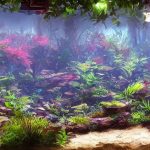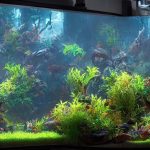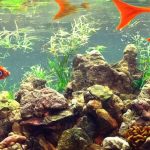Are you struggling with fish tank algae? This blog post will teach you everything you need to know about algae, including what it is, why it happens, and how to get rid of it. We’ll also discuss some tips for preventing algae growth in the future.
What is Algae in a Fish Tank
Algae are simple, plant-like organisms that live in water. They can be found in all types of water, including fish tanks. They can be single-celled or multicellular, and they come in a variety of shapes and sizes. Algae are found in all types of water, including oceans, lakes, rivers, and even fish tanks.
Types of Algae in Fish Tanks
Algae come in many different shapes, sizes, and colors. Some algae are beneficial for fish tanks, while others can be harmful.
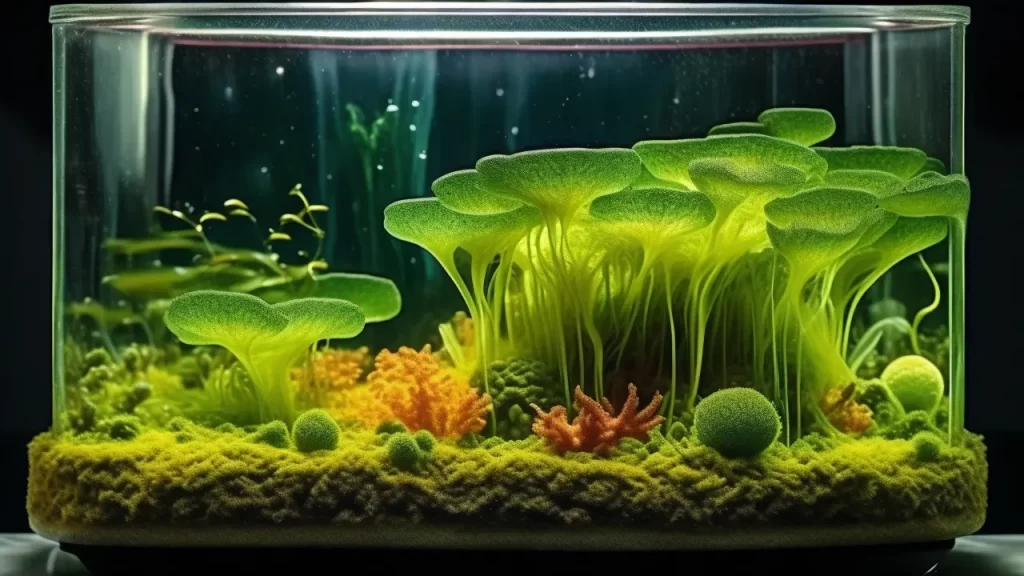
Beneficial algae: This type of algae is an important food source for fish and helps keep the water clean. They can also help to control the growth of other algae.
Harmful algae: This type of algae can reduce oxygen levels in the water, leading to fish death. They can also produce toxins that can harm fish.
Here are some of the most common types of algae found in fish tanks:
Green algae
This is the most common type of algae found in fish tanks. It is a single-celled organism that can grow in a variety of shapes and sizes. Green algae is usually not harmful to fish, but it can make the water cloudy and unsightly.
Brown algae
This type of algae is also known as diatoms. It is made up of single-celled organisms that have a hard outer shell. Brown algae can grow on the sides of the tank, the substrate, and the plants. It can be harmful to fish if it grows too much.
Black algae
This type of algae is also known as black beard algae. It is a single-celled organism that can grow in long, stringy strands. Black algae can be harmful to fish if it grows too much and blocks their gills.
Blue-green algae
This type of algae is also known as cyanobacteria. It is a photosynthetic organism that can produce toxins that are harmful to fish. Blue-green algae can also make the water cloudy and unsightly.
How to Deal with Algae in Fish Tank
Algae can be a common problem in fish tanks, but there are a number of things you can do to deal with it. Here are some tips:
- Reduce the amount of light: Algae need light to grow, so reducing the amount of light that reaches your tank is one of the best ways to control algae growth. You can do this by covering the tank with a light-blocking material or by moving the tank to a shadier location.
- Reduce the amount of nutrients: Algae also need nutrients to grow, so reducing the amount of nutrients in the water can also help to control algae growth. You can do this by changing the water more frequently and by using a filter that removes nutrients from the water.
- Improve water quality: Poor water quality can also make it more difficult to control algae growth. You can improve water quality by testing the water regularly and making sure that the levels of ammonia, nitrite, and nitrate are within the safe range.
- Use an algaecide: Algaecides can be effective at killing algae, but they can also be harmful to fish. It is important to use them carefully and to follow the directions on the label.
- Add algae-eating fish: There are a number of fish that eat algae, such as otocinclus, Siamese algae eaters, and clown loaches. Adding these fish to your tank can help to keep the algae population under control.
- Remove algae manually: If you have a small amount of algae, you can remove it manually by scraping it off the tank walls and decorations.
By following these tips, you can help to keep your fish tank clean and free of algae.
Here are some additional tips:
- Choose the right plants: Some plants, such as Anubias and Java fern, are less likely to attract algae than others.
- Avoid overfeeding your fish: Overfeeding your fish can lead to an increase in nutrients in the water, which can promote algae growth.
- Clean your filter regularly: A dirty filter can release nutrients into the water, which can also promote algae growth.
- Test your water regularly: Regularly testing your water will help you to identify any problems early on, such as high levels of nutrients or poor water quality.
By following these tips, you can help prevent algae growth in your fish tank and keep your fish healthy.
What Kinds of Fish Eat Algae?
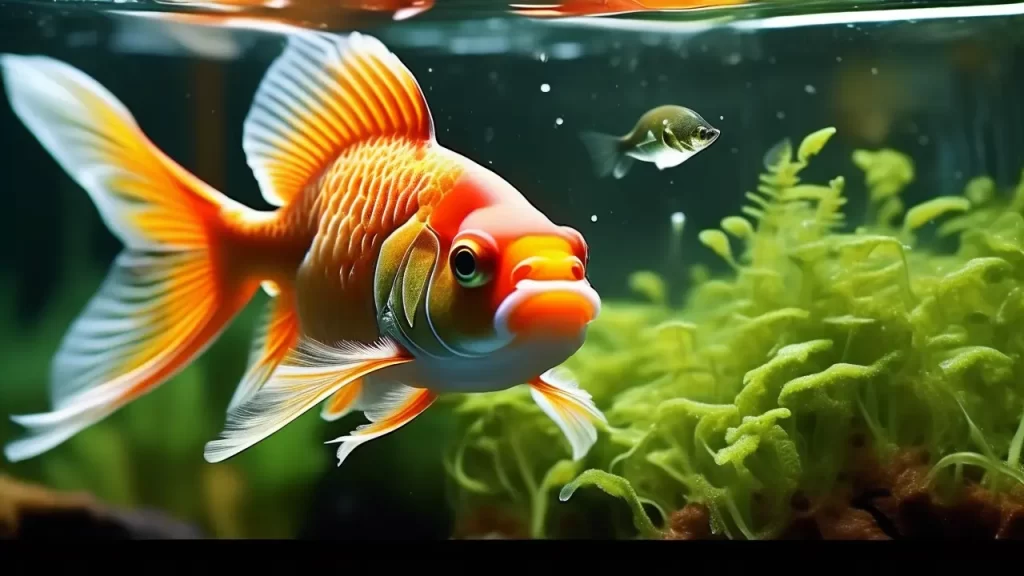
There are many different types of fish that eat algae. Some of the most common algae-eating fish include:
- Otocinclus: These small catfish are native to South America and are known for their algae-eating abilities. They are peaceful fish that are easy to care for and make great additions to community tanks.
- Siamese algae eater: These fish are also native to South America and are similar in appearance to otocinclus. They are a bit larger than otocinclus and can be more aggressive, but they are still relatively easy to care for
- Clown loach: These fish are native to Southeast Asia and are known for their bright colors and playful personalities. They are not as voracious algae eaters as otocinclus or Siamese algae eaters, but they will still help to keep your tank clean.
- Guppy: These small fish are popular for their bright colors and easy care. While guppies are not primarily algae eaters, they will sometimes nibble on algae
- Platy: These fish are similar to guppies in appearance and care requirements. They will also sometimes nibble on algae.
If you are looking for fish that will help to keep your tank clean by eating algae, these are some of the best options. Here’s the video for the otocinclus eating algae:
When choosing algae-eating fish, it is important to consider the size of your tank and the other fish that you have.
Some algae-eating fish, such as otocinclus, are very small and should only be kept in tanks that are at least 10 gallons. Other algae-eating fish, such as Siamese algae eaters, can grow to be quite large and may need larger tanks.
It is also important to make sure that the algae-eating fish that you choose are compatible with the other fish in your tank. Some algae-eating fish, such as Siamese algae eaters, can be aggressive and may not do well with other peaceful fish.
Benefits of Algae-eating Fish
There are many benefits to having algae-eating fish in your tank. Here are a few:
- They help to keep your tank clean. Algae can quickly become a problem in fish tanks, but algae-eating fish can help to keep it under control. They will eat the algae that grow on the tank walls, decorations, and even on the fish themselves.
- They help to improve water quality. Algae can release toxins into the water, which can be harmful to fish. Algae-eating fish can help to reduce the amount of algae in the water, which can improve water quality and make it healthier for your fish.
- They can help to reduce stress levels in fish. Algae can be unsightly and can make fish feel stressed. Algae-eating fish can help to reduce the amount of algae in the tank, which can make the fish feel more comfortable and relaxed.
- They can help to control the population of other fish. Some algae-eating fish, such as Siamese algae eaters, can be aggressive and may eat the eggs or fry of other fish. However, they can also help to control the population of other fish by eating the algae that they feed on.
- They can add interest to your tank. Algae-eating fish come in a variety of colors and sizes, so they can add interest to your tank and make it more visually appealing.
If you are looking for a way to keep your fish tank clean and healthy, algae-eating fish are a great option. They are relatively easy to care for and can provide many benefits to your tank.
How to Provide Algae for Fishes
Here are some ways to provide algae for fishes:
Live algae
There are many different types of live algae that can be used to feed fish. Some of the most common types include:
- Green algae: This is a good source of food for many fish, and it also helps to keep the water clean by absorbing nutrients.
- Brown algae: This type of algae helps to stabilize the water and provide a habitat for small organisms.
- Blue-green algae: This type of algae produces oxygen, which is essential for fish.
Live algae can be purchased from pet stores or online retailers. It can also be grown in your own tank.
Freeze-dried algae
Freeze-dried algae is a convenient way to feed fish. It is also a good source of nutrients, but it is not as nutritious as live algae.
Freeze-dried algae can be purchased from pet stores or online retailers.
Algae wafers
Algae wafers are a type of food that is specifically designed for fish. They are made from a variety of ingredients, including algae, and they are a good source of nutrients for fish.
Algae wafers can be purchased from pet stores or online retailers.
Algae supplements
Algae supplements are a type of food that can be added to the fish’s diet. They are made from a variety of ingredients, including algae, and they can help to supplement the fish’s diet with essential nutrients.
Algae supplements can be purchased from pet stores or online retailers.
When choosing algae to feed your fish, it is important to consider the type of fish you have. Some fish prefer live algae, while others prefer freeze-dried or algae wafers. It is also important to make sure that the algae you choose is a good source of nutrients for your fish.
It is also important to feed your fish the right amount of algae. Too much algae can pollute the water and make it unhealthy for your fish. The amount of algae you feed your fish will depend on the size of your fish and their diet.
Maintenance Considerations for Fish-eating Algae
Here are some maintenance considerations for fish-eating algae:
- Water quality: Algae-eating fish are sensitive to water quality, so it is important to keep the water clean and free of pollutants. You can do this by changing the water regularly and by using a filter to remove debris and waste.
- Lighting: Algae-eating fish need a moderate amount of light to thrive. Too much light can encourage algae growth, while too little light can stress the fish.
- Food: Algae-eating fish are not as voracious as other types of fish, so you do not need to feed them as often. You can feed them a small amount of algae wafers or live algae daily.
- Tank mates: Algae-eating fish are generally peaceful, but they can be aggressive towards other fish that compete for food. It is important to choose tank mates carefully.
- Health: Algae-eating fish are generally healthy, but they can be susceptible to parasites and diseases. It is important to quarantine new fish before adding them to the tank and to monitor the fish for any signs of illness.
Conclusion
- In conclusion, dealing with fish tank algae is a common challenge for many aquarium owners. – Understanding the different types of algae and their causes is crucial in finding effective solutions.
- Regular maintenance, such as regular water changes, cleaning equipment, and proper lighting management can help prevent algae growth.
- Additionally, introducing live plants and algae-eating fish can provide natural control.
- If all else fails, there are chemical treatments available that can effectively eliminate algae.
With these tips and strategies in mind, aquarium enthusiasts can maintain a clean and healthy environment for their aquatic pets. Don’t let fish tank algae take over your tank – take action today to keep your aquarium thriving.

